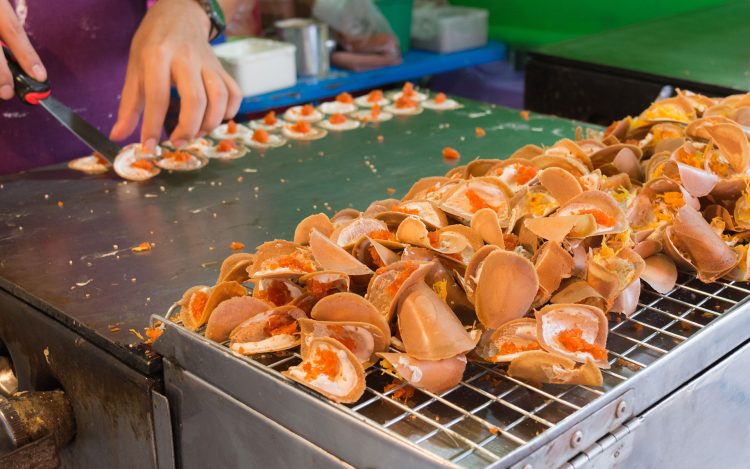The Cultural Significance of Street Food in Thailand
Thailand’s vibrant street food scene is an essential part of the country’s identity, offering not only delicious flavors but also a glimpse into the cultural and social fabric of Thai society. From bustling urban centers like Bangkok to smaller towns, street food vendors are a ubiquitous feature of daily life, offering an endless variety of dishes that reflect the country’s deep culinary traditions. Street food in Thailand is more than just a quick meal; it is a cultural institution that embodies the Thai approach to food, community, and hospitality.
At its heart, Thai street food reflects the core values of Thai culture—simplicity, flavor, and shared experiences. Eating on the street is an experience that allows both locals and tourists to connect with each other. Food is not only a source of nourishment but also a means of bringing people together, fostering a sense of community and belonging. The tradition of eating on the streets has a long history, dating back centuries when markets and local vendors were central to everyday life. Over time, this tradition has evolved into one of Thailand’s most iconic and beloved aspects of daily life.
Street food in Thailand also reflects the country’s rich culinary diversity, shaped by centuries of influences from neighboring countries like China, India, and Malaysia, as well as centuries of local innovation. The fusion of sweet, salty, sour, and spicy flavors is central to Thai cuisine, and these distinctive tastes are often featured in street food dishes, making them a unique representation of the country’s gastronomic heritage.
Food markets, which are often the heart of Thai street food culture, serve not only as venues for eating but also as spaces for socialization and cultural exchange. Whether it’s enjoying a bowl of steaming noodles in a lively market or savoring a plate of grilled skewers on a quiet street corner, the experience of eating Thai street food is as much about the people and the environment as it is about the food itself.
Must-Try Dishes: Pad Thai, Som Tum, and Mango Sticky Rice
Thai street food is an explosion of flavors, with a wide range of dishes that are unique in their balance of sweet, salty, sour, and spicy elements. While there are countless options to choose from, three iconic dishes stand out as must-try experiences for anyone exploring the Thai street food scene: Pad Thai, Som Tum, and Mango Sticky Rice.
- Pad Thai
Perhaps the most famous Thai dish outside of Thailand, Pad Thai is a beloved stir-fried noodle dish that has become a symbol of Thai street food. Pad Thai features rice noodles stir-fried with eggs, tofu, shrimp, or chicken, along with a combination of ingredients such as peanuts, bean sprouts, garlic, and lime. The key to Pad Thai’s deliciousness lies in the balance of flavors, with tamarind providing a sour note, fish sauce contributing saltiness, sugar adding sweetness, and chili bringing the heat. It’s often garnished with fresh herbs and served with a wedge of lime to enhance the overall flavor profile.
Pad Thai was originally a Chinese-inspired dish brought to Thailand in the mid-20th century, but over time it evolved into the iconic street food that we know today. Its rise to fame was largely due to government efforts in the 1930s to create a national dish that reflected Thai identity. Today, Pad Thai can be found on nearly every street corner in Thailand, from small roadside vendors to bustling food markets. Whether enjoyed as a quick lunch or a late-night snack, Pad Thai is an absolute must-try for anyone visiting Thailand.

- Som Tum (Papaya Salad)
Som Tum, a spicy and tangy papaya salad, is another iconic Thai street food that offers a true taste of Thai flavors. Made with shredded green papaya, lime juice, fish sauce, chili, garlic, and peanuts, Som Tum is a refreshing dish that packs a punch. The combination of sourness from lime, saltiness from fish sauce, sweetness from sugar, and heat from chili makes Som Tum a complex and satisfying dish that is perfect for balancing the heat of the Thai climate.
Som Tum has a long history in Thai cuisine, believed to have originated in the northeastern region of Isaan, where it is still a staple. In the streets of Bangkok, however, Som Tum is often made with additional ingredients like dried shrimp, salted crab, and tomatoes, creating unique variations. The dish is commonly enjoyed with sticky rice and grilled meats, creating a perfect balance of flavors and textures.
- Mango Sticky Rice
For those with a sweet tooth, Mango Sticky Rice (Khao Niew Mamuang) is the perfect way to end a Thai street food meal. This simple yet heavenly dessert consists of ripe mango slices served with sticky rice and a drizzle of coconut milk. The rice is sweetened with sugar and salt, while the mango provides a juicy and fragrant contrast. The rich, creamy coconut milk ties everything together, making this dish a popular choice for both locals and visitors alike.
Mango Sticky Rice is typically available during mango season, which runs from April to June, and is a favorite treat for Thais during the hot summer months. Vendors can be found in markets all over Thailand, where they often serve the dish in small plastic containers for easy enjoyment on the go. The combination of creamy rice and sweet mango is a perfect representation of the simplicity and balance that defines Thai street food.
How Food Markets Reflect Local Customs and Social Life
Food markets in Thailand are not only places to buy and eat food—they are also social hubs that reflect the daily life, culture, and traditions of the Thai people. Street food markets are often bustling with activity, with vendors shouting to attract customers, the smell of sizzling food filling the air, and locals gathering to enjoy a meal with family and friends. The markets are spaces where communities come together, share meals, and bond over food.
Markets such as Chatuchak Market in Bangkok and Tha Phra Chan Market in Ayutthaya are perfect examples of how food markets serve as cultural centers. In these markets, food is often prepared in front of customers, and people come together to enjoy meals that reflect local traditions and practices. These markets are not just about eating—they are about socializing, exchanging stories, and celebrating the joy of food.
Street food markets also offer a glimpse into the diversity of Thai culture, with different regions contributing their own specialties. In the north, you might find Khao Soi, a rich coconut curry noodle dish, while in the south, vendors may serve Massaman curry or Satay. In Isaan, the region known for its spicy food, you’ll find dishes like Laab and Grilled Chicken. The variety and complexity of Thai street food highlight the country’s cultural and culinary diversity.
The Role of Street Food in Thai Festivals and Traditions
Street food plays an important role in many of Thailand’s festivals and cultural traditions. During the Loy Krathong festival, for example, food vendors line the banks of rivers, offering special sweets and treats that reflect the spirit of the festival. Similarly, during the Songkran festival, street food is central to the celebrations, with people gathering in the streets to enjoy dishes that celebrate Thai New Year, such as Pad See Ew and Khao Chae.
Street food is also a key feature of the Yi Peng festival in northern Thailand, where vendors sell foods like Sai Oua (a spicy sausage) and Khao Niew Moo Ping (grilled pork skewers) to celebrate the occasion. At these festivals, food becomes more than just a meal—it becomes a way to connect with others, to honor cultural traditions, and to celebrate the country’s heritage.
The festive nature of Thai street food is further reflected in the way food is served and consumed during these festivals. Often, dishes are shared among friends and family, reinforcing the communal aspect of Thai food culture. The act of eating together, sharing a meal, and enjoying food in the company of others is a core element of Thai society, and this is evident during major holidays and celebrations.
Best Markets to Visit for an Authentic Street Food Experience
While street food can be found throughout Thailand, there are several markets that stand out as the best places to experience the diversity and excitement of Thai street food culture. Here are some of the top markets to visit for an authentic street food experience:
- Chatuchak Market (Bangkok): Known as the largest market in Thailand, Chatuchak is a bustling maze of stalls selling everything from clothes and souvenirs to food and drinks. The food section is a must-visit, offering everything from grilled meats to Thai iced teas and coconut desserts.
- Yaowarat (Bangkok’s Chinatown): Yaowarat is famous for its street food, particularly its seafood. The market comes alive at night, with vendors serving up dishes like Tom Yum Goong (spicy shrimp soup), Grilled Squid, and Dim Sum. It’s the perfect place to sample authentic Chinese-influenced Thai street food.
- Chiang Mai’s Night Bazaar: For a more laid-back, yet equally delicious street food experience, head to Chiang Mai’s Night Bazaar. This market is known for its local northern Thai dishes, including Khao Soi (curry noodles) and Sai Oua (spicy sausage), as well as a variety of snacks and desserts.
- Hua Hin Night Market: Located along the coast, Hua Hin’s Night Market is a great place to try fresh seafood and traditional Thai street food. From Pad Thai to Grilled Fish, the market offers a wide variety of tasty treats.
- Bangkok’s Talad Rot Fai (Train Market): For those seeking a more vintage vibe, Talad Rot Fai is a must-visit. This market is known for its retro atmosphere, as well as its delicious street food. Try dishes like Grilled Pork Skewers or Pad Kee Mao (drunken noodles) as you explore the market.
Conclusion
Thai street food is a reflection of the country’s rich cultural heritage, blending centuries of culinary tradition with modern innovation. Whether it’s savoring a plate of Pad Thai, enjoying the heat of Som Tum, or indulging in the sweet delight of Mango Sticky Rice, the flavors of Thai street food offer a window into the country’s history, values, and social life. Visiting food markets in Thailand is not just about eating—it’s about experiencing the pulse of local culture, celebrating tradition, and sharing in the joy of food with others.





















